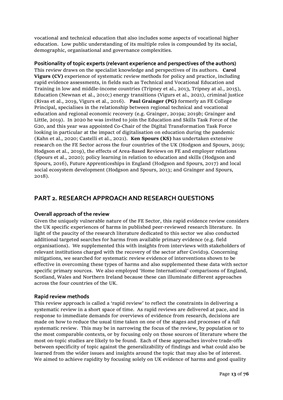
Page 13 of 76
vocational and technical education that also includes some aspects of vocational higher
education. Low public understanding of its multiple roles is compounded by its social,
demographic, organisational and governance complexities.
Positionality of topic experts (relevant experience and perspectives of the authors)
This review draws on the specialist knowledge and perspectives of its authors. Carol
Vigurs (CV) experience of systematic review methods for policy and practice, including
rapid evidence assessments, in fields such as Technical and Vocational Education and
Training in low and middle-income countries (Tripney et al., 2013, Tripney at al., 2015),
Education (Newnan et al., 2010;) energy transitions (Vigurs et al., 2021), criminal justice
(Rivas et al., 2019, Vigurs et al., 2016). Paul Grainger (PG) formerly an FE College
Principal, specialises in the relationship between regional technical and vocational
education and regional economic recovery (e.g. Grainger, 2019a; 2019b; Grainger and
Little, 2019). In 2020 he was invited to join the Education and Skills Task Force of the
G20, and this year was appointed Co-Chair of the Digital Transformation Task Force
looking in particular at the impact of digitalisation on education during the pandemic
(Kahn et al., 2020; Castelli et al., 2021). Ken Spours (KS) has undertaken extensive
research on the FE Sector across the four countries of the UK (Hodgson and Spours, 2019;
Hodgson et al., 2019), the effects of Area-Based Reviews on FE and employer relations
(Spours et al., 2020); policy learning in relation to education and skills (Hodgson and
Spours, 2016), Future Apprenticeships in England (Hodgson and Spours, 2017) and local
social ecosystem development (Hodgson and Spours, 2013; and Grainger and Spours,
2018).
PART 2. RESEARCH APPROACH AND RESEARCH QUESTIONS
Overall approach of the review
Given the uniquely vulnerable nature of the FE Sector, this rapid evidence review considers
the UK specific experiences of harms in published peer-reviewed research literature. In
light of the paucity of the research literature dedicated to this sector we also conducted
additional targeted searches for harms from available primary evidence (e.g. field
organisations). We supplemented this with insights from interviews with stakeholders of
relevant institutions charged with the recovery of the sector after Covid19. Concerning
mitigations, we searched for systematic review evidence of interventions shown to be
effective in overcoming these types of harms and also supplemented these data with sector
specific primary sources. We also employed 'Home International' comparisons of England,
Scotland, Wales and Northern Ireland because these can illuminate different approaches
across the four countries of the UK.
Rapid review methods
This review approach is called a 'rapid review' to reflect the constraints in delivering a
systematic review in a short space of time. As rapid reviews are delivered at pace, and in
response to immediate demands for overviews of evidence from research, decisions are
made on how to reduce the usual time taken on one of the stages and processes of a full
systematic review. This may be in narrowing the focus of the review, by population or to
the most comparable contexts, or by focusing only on those sources of literature where the
most on-topic studies are likely to be found. Each of these approaches involve trade-offs
between specificity of topic against the generalizability of findings and what could also be
learned from the wider issues and insights around the topic that may also be of interest.
We aimed to achieve rapidity by focusing solely on UK evidence of harms and good quality